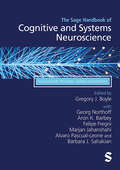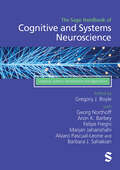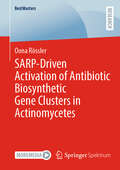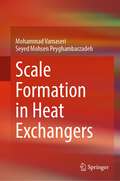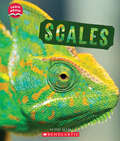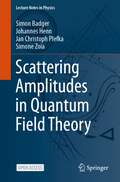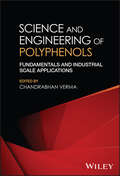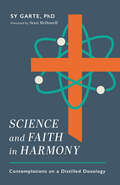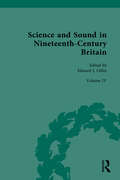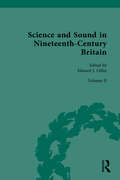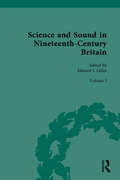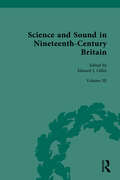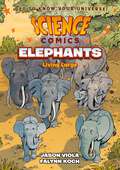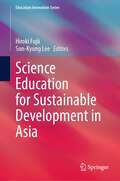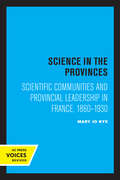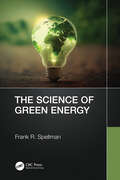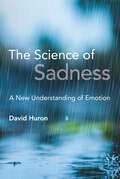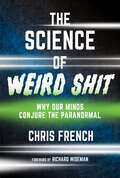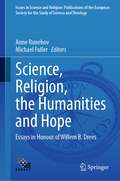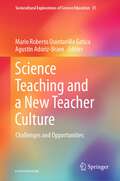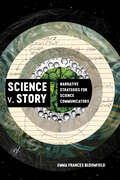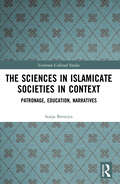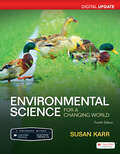- Table View
- List View
The Sage Handbook of Cognitive and Systems Neuroscience: Neuroscientific Principles, Systems and Methods
by Gregory J. Boyle Georg Northoff Aron K. Barbey Felipe Fregni Marjan Jahanshahi Alvaro Pascual-Leone Barbara J. SahakianCognitive neuroscience is the interdisciplinary study of how cognitive and intellectual functions are processed and represented within the brain, which is critical to building understanding of core psychological and behavioural processes such as learning, memory, behaviour, perception, and consciousness. Understanding these processes not only offers relevant fundamental insights into brain-behavioural relations, but may also lead to actionable knowledge that can be applied in the clinical treatment of patients with various brain-related disabilities. This Handbook focusses on the foundational principles, methods, and underlying systems in cognitive and systems neuroscience, as well as examining cutting-edge methodological advances and innovations. Containing 34 original, state of the art contributions from leading experts in the field, this Handbook is essential reading for researchers and students of cognitive psychology, as well as scholars across the fields of neuroscientific, behavioural and health sciences. Part 1: Background Considerations Part 2: Neuroscientific Substrates and Principles Part 3: Neuroanatomical Brain Systems Part 4: Neural Dynamics and Processes Part 5: Sensory-Perceptual Systems and Cognition Part 6: Methodological Advances
The Sage Handbook of Cognitive and Systems Neuroscience: Neuroscientific Principles, Systems and Methods
by Gregory J. Boyle Georg Northoff Aron K. Barbey Felipe Fregni Marjan Jahanshahi Alvaro Pascual-Leone Barbara J. SahakianCognitive neuroscience is the interdisciplinary study of how cognitive and intellectual functions are processed and represented within the brain, which is critical to building understanding of core psychological and behavioural processes such as learning, memory, behaviour, perception, and consciousness. Understanding these processes not only offers relevant fundamental insights into brain-behavioural relations, but may also lead to actionable knowledge that can be applied in the clinical treatment of patients with various brain-related disabilities. This Handbook focusses on the foundational principles, methods, and underlying systems in cognitive and systems neuroscience, as well as examining cutting-edge methodological advances and innovations. Containing 34 original, state of the art contributions from leading experts in the field, this Handbook is essential reading for researchers and students of cognitive psychology, as well as scholars across the fields of neuroscientific, behavioural and health sciences. Part 1: Background Considerations Part 2: Neuroscientific Substrates and Principles Part 3: Neuroanatomical Brain Systems Part 4: Neural Dynamics and Processes Part 5: Sensory-Perceptual Systems and Cognition Part 6: Methodological Advances
The Sage Handbook of Cognitive and Systems Neuroscience: Cognitive Systems, Development and Applications
by Gregory J. Boyle Georg Northoff Aron K. Barbey Felipe Fregni Marjan Jahanshahi Alvaro Pascual-Leone Barbara J. SahakianCognitive neuroscience is the interdisciplinary study of how cognitive and intellectual functions are processed and represented within the brain, which is critical to building understanding of core psychological and behavioural processes such as learning, memory, behaviour, perception, and consciousness. Understanding these processes not only offers relevant fundamental insights into brain-behavioural relations, but may also lead to actionable knowledge that can be applied in the clinical treatment of patients with various brain-related disabilities. This Handbook examines complex cognitive systems through the lens of neuroscience, as well as providing an overview of development and applications within cognitive and systems neuroscience research and beyond. Containing 35 original, state of the art contributions from leading experts in the field, this Handbook is essential reading for researchers and students of cognitive psychology, as well as scholars across the fields of neuroscientific, behavioural and health sciences. Part 1: Attention, Learning and Memory Part 2: Language and Communication Part 3: Emotion and Motivation Part 4: Social Cognition Part 5: Cognitive Control and Decision Making Part 6: Intelligence
The Sage Handbook of Cognitive and Systems Neuroscience: Cognitive Systems, Development and Applications
by Gregory J. Boyle Georg Northoff Aron K. Barbey Felipe Fregni Marjan Jahanshahi Alvaro Pascual-Leone Barbara J. SahakianCognitive neuroscience is the interdisciplinary study of how cognitive and intellectual functions are processed and represented within the brain, which is critical to building understanding of core psychological and behavioural processes such as learning, memory, behaviour, perception, and consciousness. Understanding these processes not only offers relevant fundamental insights into brain-behavioural relations, but may also lead to actionable knowledge that can be applied in the clinical treatment of patients with various brain-related disabilities. This Handbook examines complex cognitive systems through the lens of neuroscience, as well as providing an overview of development and applications within cognitive and systems neuroscience research and beyond. Containing 35 original, state of the art contributions from leading experts in the field, this Handbook is essential reading for researchers and students of cognitive psychology, as well as scholars across the fields of neuroscientific, behavioural and health sciences. Part 1: Attention, Learning and Memory Part 2: Language and Communication Part 3: Emotion and Motivation Part 4: Social Cognition Part 5: Cognitive Control and Decision Making Part 6: Intelligence
SARP-Driven Activation of Antibiotic Biosynthetic Gene Clusters in Actinomycetes (BestMasters)
by Oona RösslerActinomycetes are a group of Gram-positive bacteria of which many representatives are prominent for being prolific producers of bioactive natural products including antibiotics, fungicides, antitumor agents, or immunosuppressants. SARP transcriptional regulators are widely distributed among actinomycetes, especially in streptomycetes and are known to activate antibiotic biosynthesis. The set of genes responsible for the production of natural products, including pathway specific transcriptional regulators such as SARPs, are typically located in contiguous regions of the genome known as "biosynthetic gene clusters" (BGCs). In this book, Oona Rössler reports on the activation of antibiotic BGCs in selected actinomycetes strains upon heterologous expression of the SARP-type regulator PapR2 from Streptomyces pristinaespiralis. Applying a bioinformatic screening for the abundance of SARP genes and SARP consensus sequences as part of BGCs, the author has selected actinomycetes candidate strains from the DSMZ strain collection for heterologous SARP expression. It is shown that overexpression of papR2 increased the production of predominantly unknown antimicrobial compounds in more than half of the selected actinomycetes strains, as observed by bioassays against different microbial test strains including bacteria and fungi.
Scale Formation in Heat Exchangers
by Mohammad Varnaseri Seyed Mohsen PeyghambarzadehThis book brings together a wide range of current research to create a holistic understanding of fouling. It draws upon practical and laboratory experiences spanning many years. While offering an overview of various fouling types, the book's emphasis is on crystallization fouling, a facet seldom addressed in the existing literature. Furthermore, this book goes beyond theory by providing practical examples for heat exchanger design, incorporating the pivotal consideration of fouling's impact. It focuses especially on calcium salts such as calcium carbonate and calcium sulfate.Fouling formation represents a ubiquitous challenge across diverse industrial sectors, spanning oil, gas, petrochemicals, food, pharmaceuticals, and power generation. This encroaching fouling, prevalent within heating equipment, not only jeopardizes the integrity of machinery but also significantly saps energy resources. Consequently, extensive research efforts have been undertaken to comprehensively explore fouling formation through both experimental and theoretical avenues across various heating apparatuses. The book's mission is to facilitate a broader comprehension of crystallization fouling research, revealing the various factors influencing this form of fouling. Additionally, it critiques prior research endeavors, identifying their strengths and weaknesses while pinpointing potential avenues for future investigation
Scales (Learn About)
by Eric GeronLet's learn all about the different types of animal coverings!Which animals have scales? Fish! Did you know that some birds, reptiles, and mammals can also have scales? Discover all the incredible ways scales help animals survive. With amazing photos and lively text, this book explains how scales help animals stay warm or cool, move, protect themselves, and more! Get ready to learn all about scales!ABOUT THE SERIES:Animals have different body coverings for different reasons. Some animals use their coverings to keep warm or stay cool, others use them for protection, and can either stand out or blend in. Some animals even use their coverings to move! This vibrant new set of Learn About books gives readers a close-up look at five different animal coverings, from fur and feathers to skin, scales, and shells. Each book is packed with photographs and fun facts that explore how each covering suits the habitat, diet, survival, and life cycle of various animals in the natural world.
Scattering Amplitudes in Quantum Field Theory (Lecture Notes in Physics #1021)
by Simon Badger Johannes Henn Jan Christoph Plefka Simone ZoiaThis open access book bridges a gap between introductory Quantum Field Theory (QFT) courses and state-of-the-art research in scattering amplitudes. It covers the path from basic definitions of QFT to amplitudes, which are relevant for processes in the Standard Model of particle physics. The book begins with a concise yet self-contained introduction to QFT, including perturbative quantum gravity. It then presents modern methods for calculating scattering amplitudes, focusing on tree-level amplitudes, loop-level integrands and loop integration techniques. These methods help to reveal intriguing relations between gauge and gravity amplitudes and are of increasing importance for obtaining high-precision predictions for collider experiments, such as those at the Large Hadron Collider, as well as for foundational mathematical physics studies in QFT, including recent applications to gravitational wave physics.These course-tested lecture notes include numerous exercises with solutions. Requiring only minimal knowledge of QFT, they are well-suited for MSc and PhD students as a preparation for research projects in theoretical particle physics. They can be used as a one-semester graduate level course, or as a self-study guide for researchers interested in fundamental aspects of quantum field theory.
Science and Engineering of Polyphenols: Fundamentals and Industrial Scale Applications
by Chandrabhan VermaSCIENCE AND ENGINEERING OF POLYPHENOLS A groundbreaking synthesis of rich and varied polyphenol research Polyphenols are a class of compounds, found naturally in fruits and vegetables, whose flexibility and ubiquity give them a vast range of applications in pharmaceutical, environmental, and biological research and development. They play a role in diagnosing and preventing diseases from diabetes to Parkinson’s to Alzheimer’s and have been integral in food preservation. The field of polyphenols research has the potential to touch virtually every area of organic production. Science and Engineering of Polyphenols provides a current and comprehensive overview of this field of research and its latest developments. Long overdue as a ‘state of the field’ synthesis for an area of study that has seen rapid development in recent years, this book promises to be a milestone. Science and Engineering of Polyphenols readers will also find: Treatment of both natural and synthetic polyphenols Detailed discussion of topics including synthesis and characterization of polyphenols, electronic and molecular structure of polyphenols, and many more Supplementary material including websites of interest and updates on the latest research and development Science and Engineering of Polyphenols is ideal for scholars, industrialists, and policymakers in any of the myriad areas of academia and industry touched by polyphenol research.
Science and Faith in Harmony: Contemplations on a Distilled Doxology
by Sy GarteRather than discord between science and Christian faith, there is a harmony as grand as any choral masterpiece The idea that Christianity and science are inextricably in conflict is a relatively recent conception. However, with each new scientific discovery and scriptural insight, it's an idea that's being proved to be insupportable. Sy Garte has immersed himself in both science and faith and knows they work beautifully together to sing of the greatness of God. Now this respected scientist shares how God's world (nature and science) and God's word (made flesh in Christ) are bound together in loving harmony. In Science and Faith in Harmony, Garte examines modern scientific concepts and what they can teach us about theological truths, such as the dual nature of Christ. He explores the ways in which the terminology and language of science and faith consistently match each other. Despite his deep dives into theology and science, Garte does not get overly technical in his writing. Instead, he is personal and passionate, speaking directly to readers with a tone of joy and wonder, inviting them to join the chorus of praise to the Lord. Readers still wondering whether the truths of science and Christian faith are in conflict need this book. Following the path of Christ and holding a scientific worldview at the same time is not only possible but also leads to a fuller, richer life of harmony and truth.
Science and Sound in Nineteenth-Century Britain: Sound Transformer (Nineteenth-Century Science, Technology and Medicine: Sources and Documents #4)
by Edward J. GillinSound and Science in Nineteenth-Century Britain is a four-volume set of primary sources which seeks to define our historical understanding of the relationship between British scientific knowledge and sound between 1815 and 1900. In the context of rapid urbanization and industrialization, as well as a growing overseas empire, Britain was home to a rich scientific culture in which the ear was as valuable an organ as the eye for examining nature. Experiments on how sound behaved informed new understandings of how a diverse array of natural phenomena operated, notably those of heat, light, and electro-magnetism. In nineteenth-century Britain, sound was not just a phenomenon to be studied, but central to the practice of science itself and broader understandings over nature and the universe. This collection, accompanied by extensive editorial commentary, will be of great interest to students and scholars of the History of Science.
Science and Sound in Nineteenth-Century Britain: Philosophies and Epistemologies of Sound (Nineteenth-Century Science, Technology and Medicine: Sources and Documents #2)
by Edward J. GillinScience and Sound in Nineteenth-Century Britain is a four-volume set of primary sources which seeks to define our historical understanding of the relationship between British scientific knowledge and sound between 1815 and 1900. In the context of rapid urbanization and industrialization, as well as a growing overseas empire, Britain was home to a rich scientific culture in which the ear was as valuable an organ as the eye for examining nature. Experiments on how sound behaved informed new understandings of how a diverse array of natural phenomena operated, notably those of heat, light, and electro-magnetism. In nineteenth-century Britain, sound was not just a phenomenon to be studied, but central to the practice of science itself and broader understandings over nature and the universe. This collection, accompanied by extensive editorial commentary, will be of great interest to students and scholars of the History of Science.
Science and Sound in Nineteenth-Century Britain: Sounds Experimental and Entertaining (Nineteenth-Century Science, Technology and Medicine: Sources and Documents #1)
by Edward J. GillinSound and Science in Nineteenth-Century Britain is a four-volume set of primary sources which seeks to define our historical understanding of the relationship between British scientific knowledge and sound between 1815 and 1900. In the context of rapid urbanization and industrialization, as well as a growing overseas empire, Britain was home to a rich scientific culture in which the ear was as valuable an organ as the eye for examining nature. Experiments on how sound behaved informed new understandings of how a diverse array of natural phenomena operated, notably those of heat, light, and electro-magnetism. In nineteenth-century Britain, sound was not just a phenomenon to be studied, but central to the practice of science itself and broader understandings over nature and the universe. This collection, accompanied by extensive editorial commentary, will be of great interest to students and scholars of the History of Science.
Science and Sound in Nineteenth-Century Britain: Sound in Context (Nineteenth-Century Science, Technology and Medicine: Sources and Documents #3)
by Edward J. GillinScience and Sound in Nineteenth-Century Britain is a four-volume set of primary sources which seeks to define our historical understanding of the relationship between British scientific knowledge and sound between 1815 and 1900. In the context of rapid urbanization and industrialization, as well as a growing overseas empire, Britain was home to a rich scientific culture in which the ear was as valuable an organ as the eye for examining nature. Experiments on how sound behaved informed new understandings of how a diverse array of natural phenomena operated, notably those of heat, light, and electro-magnetism. In nineteenth-century Britain, sound was not just a phenomenon to be studied, but central to the practice of science itself and broader understandings over nature and the universe. This collection, accompanied by extensive editorial commentary, will be of great interest to students and scholars of the History of Science.
Science Comics: Living Large (Science Comics)
by Jason ViolaHave you herd? There's a new volume in First Second's STEM graphic novel series: Science Comics: Elephants!Did you know elephants are the world's largest land animals? Male African elephants can reach ten feet tall and weigh up to 16,500 pounds! These endangered animals are beloved for their massive ears, thick skin, and flexible trunks, as well as their remarkable intelligence and empathy. And despite their size, the more you get to know them, the more you'll realize humans and elephants have a lot in common!
Science Education for Sustainable Development in Asia (Education Innovation Series)
by Hiroki Fujii Sun-Kyung LeeThis book presents an Asian perspective on transformative science education in the context of the United Nations' Sustainable Development Goals (SDGs). The chapters are written by contributors who practiced science education for sustainability in a research project entitled “Teacher Education for ESD in the Asia-Pacific Region” from 2017 to 2019, supported by the Japan Society for the Promotion of Science, and the Japanese National Commission for UNESCO. The book showcases the contributors’ innovations in science education for sustainability, presenting case studies of science teaching and learning, science curriculum and assessment, science education in collaboration with local communities, and science teacher education. Embodying Asian sustainability education paradigms, policies, and practices, these case studies depict the diversity and uniqueness of natural, social, and cultural contexts in Asia, while demonstrating their commonalities. Through examining these case studies, this book aims to provide examples for praxis, and prospects, for new science classes, curricula, and teacher education in implementing education for sustainable development.
Science in the Provinces: Scientific Communities and Provincial Leadership in France, 1860 - 1930
by Mary Jo NyeThis title is part of UC Press's Voices Revived program, which commemorates University of California Press’s mission to seek out and cultivate the brightest minds and give them voice, reach, and impact. Drawing on a backlist dating to 1893, Voices Revived makes high-quality, peer-reviewed scholarship accessible once again using print-on-demand technology. This title was originally published in 1986.
The Science of Green Energy
by Frank R. SpellmanConcern for the environment and the impacts of pollution have brought about the need to shift from the use and reliance on hydrocarbons to energy-power sources that are pollution neutral or near pollution neutral or renewable. Moreover, the impact of 200 years of industrialization and surging population growth threatens to exceed the future supply of hydrocarbon power sources. Therefore, the implementation of green energy sources is surging. The Science of Green Energy presents technologies and techniques, as well as real-world usage of and operation of today’s green energy-based applications. This practical book is designed to be used as an information source for the general reader, or for a course in energy, chemistry or in renewable energy engineering fields where green energy is becoming a key player. It is intended to fill a wide gap of missing information in published texts dealing with the green energy revolution currently in progress; it specifically provides information involving the many different sources of energy.
The Science of Sadness: A New Understanding of Emotion
by David HuronAn accessible, scientific account of grief, melancholy, and nostalgia in human life and their broader lessons for understanding emotions in general.The Science of Sadness proposes an original scientific account of grief, melancholy, and nostalgia, advocating a unique ethological approach to these familiar, woeful emotions. One of the leading scholars in the psychology of music and music cognition, David Huron draws on hundreds of studies from physiology, medicine, neuroscience, psychology, anthropology, and the arts to resolve long-standing problems that have stymied modern emotion research. A careful examination of sadness-related behaviors reveals their biological and social functions, which Huron uses to formulate a new theory about how emotions in general are displayed and interpreted.We&’ve all shed tears of joy, tears of grief, tears of pain. While different emotions often share the same weepy display, Huron identifies the single function that unites them. He suggests how weeping emerged over the course of human evolution, explores the contrasting cultural manifestations of sadness, and chronicles humanity&’s changing interpretations of sadness over time. Huron also explains the various ways cultures recruit and reshape involuntary emotional displays for different social purposes, and he offers a compelling narrative of what makes tragic arts so appealing. Though sadness is typically regarded as the very antithesis of happiness, The Science of Sadness draws attention to the important roles that grief, melancholy, and nostalgia play in human well-being.
The Science of Weird Shit: Why Our Minds Conjure the Paranormal
by Chris FrenchAn accessible and gratifying introduction to the world of paranormal beliefs and bizarre experiences.Ghostly encounters, alien abduction, reincarnation, talking to the dead, UFO sightings, inexplicable coincidences, out-of-body and near-death experiences. Are these legitimate phenomena? If not, then how should we go about understanding them? In this fascinating book, Chris French investigates paranormal claims to discover what lurks behind this &“weird shit.&” French provides authoritative evidence-based explanations for a wide range of superficially mysterious phenomena, and then goes further to draw out lessons with wider applications to many other aspects of modern society where critical thinking is urgently needed.Using academic, comprehensive, logical, and, at times, mathematical approaches, The Science of Weird Shit convincingly debunks ESP, communicating with the dead, and alien abduction claims, among other phenomena. All the while, however, French maintains that our belief in such phenomena is neither ridiculous nor trivial; if anything, such claims can tell us a great deal about the human mind if we pay them the attention they are due. Filled with light-bulb moments and a healthy dose of levity, The Science of Weird Shit is a clever, memorable, and gratifying read you won&’t soon forget.
Science, Religion, the Humanities and Hope: Essays in Honour of Willem B. Drees (Issues in Science and Religion: Publications of the European Society for the Study of Science and Theology #8)
by Anne Runehov Michael FullerThis book collects a multidisciplinary range of contributions focusing on the prolific and seminal work of Willem Drees in the fields of philosophy of religion, philosophy of the humanities, and science and theology/religion. Trained in both theoretical physics and theology/philosophy of religion, Drees holds doctoral degrees in both theology and in philosophy and, amongst other distinguished positions, held professorships at the University of Leiden and at the University of Tilburg. Drees was also Editor-in-Chief of Zygon, Journal of Religion & Science, between 2008 and 2018, and served as President of the European Society for the Study of Science and Theology (ESSSAT) between 2002 and 2008. In 2018, he was elected as member of the Royal Holland Society of Sciences and Humanities (KHMW). This contributed volume builds on Drees’ expansive and provocative scholarly contributions, notably around the concept and meaning of naturalism and the humanities to the fields of science and religion, as exemplified by his works Religion, Science and Naturalism (1996) and What Are the Humanities For? (2021). In a time where more and more young people across the globe are entering higher education such cross-disciplinary explorations and (re-)evaluations are vital to the field. Accordingly, by approaching his work from a variety of disciplines this collection illuminates the broad reach of Drees’ work and provides scholars from various fields with many new and rich opportunities avenues for research.
Science Teaching and a New Teacher Culture: Challenges and Opportunities (Sociocultural Explorations of Science Education #31)
by Mario Roberto Quintanilla Gatica Agustín Adúriz-BravoThis edited volume discusses various epistemological positions about science teaching and the complex processes of understanding and learning in the classroom. Including discussions around Natural Sciences teacher training models, as well as the development of logics of reflection on practice based on critical and dialogic interpretative visions guiding higher level competency learning. It brings together contributions from researchers promoting a coherent and robust methodological analysis, theoretically based on the systematization of evidence in different contexts within Europe and Latin America.While supporting innovation in teacher training and science teaching, it offers specific contributions and suggestions for classroom work in the subjects of Physics, Chemistry and Biology. It includes didactic guidelines for experimental practices, for the evaluation of scientific learning, as well as for the use of epistemology and the history of science in teaching. In addition, it’s considered an important contribution to the challenge of rebuilding science education programs as well as its correct implementation in schools and universities. This book is a translation of an original Spanish publication. The translation was done with the help of artificial intelligence (machine translation by the service DeepL.com). A subsequent human revision was done primarily in terms of content, so that the book will read stylistically differently from a conventional translation.
Science v. Story: Narrative Strategies for Science Communicators
by Emma Frances BloomfieldUncovering common threads across types of science skepticism to show why these controversial narratives stick and how we can more effectively counter them through storytelling Science v. Story analyzes four scientific controversies—climate change, evolution, vaccination, and COVID-19—through the lens of storytelling. Instead of viewing stories as adversaries to scientific practices, Emma Frances Bloomfield demonstrates how storytelling is integral to science communication. Drawing from narrative theory and rhetorical studies, Science v. Story examines scientific stories and rival stories, including disingenuous rival stories that undermine scientific conclusions and productive rival stories that work to make science more inclusive. Science v. Story offers two tools to evaluate and build stories: narrative webs and narrative constellations. These visual mapping tools chart the features of a story (i.e., characters, action, sequence, scope, storyteller, and content) to locate opportunities for audience engagement. Bloomfield ultimately argues that we can strengthen science communication by incorporating storytelling in critical ways that are attentive to audience and context.
The Sciences in Islamicate Societies in Context: Patronage, Education, Narratives (Variorum Collected Studies)
by Sonja BrentjesThis Variorum volume reprints ten papers on contextual elements of the so-called ancient sciences in Islamicate societies between the thirteenth and the seventeenth centuries. They address four major themes: the ancient sciences in educational institutions; courtly patronage of science; the role of the astral and other sciences in the Mamluk sultanate; and narratives about knowledge. The main arguments are directed against the then dominant historiographical claims about the exclusion of the ancient sciences from the madrasa and cognate educational institutes, the suppression of philosophy and other ancient sciences in Damascus after 1229, the limited role of the new experts for timekeeping in the educational and professional exercise of this science, and the marginal impact of astrology under Mamluk rule. It is shown that the muwaqqits (timekeepers) were important teachers at madrasas and Sufi convents, that Mamluk officers sought out astrologers for counselling and that narratives about knowledge reveal important information about scholarly debates and beliefs. Colophons and dedications are used to prove that courtly patronage for the ancient sciences continued uninterrupted until the end of the seventeenth century. Furthermore, these papers refute the idea of a continued and strong conflict between the ancient and modern sciences, showing rather shifting alliances between various of them and their regrouping in the classifications of the entire disciplinary edifice. These papers are suited for graduate teaching in the history of science and the intellectual, cultural and social history of the Middle East and for all readers interested in the study of the contexts of the sciences.
Scientific American Environmental Science for a Changing World, Digital Update
by Susan KarrReal people. Real stories. Real science.Scientific American Environmental Science for a Changing World 4e Digital Update uses magazine-style stories and cutting-edge digital resources to help you understand how the science of environmental science works.
